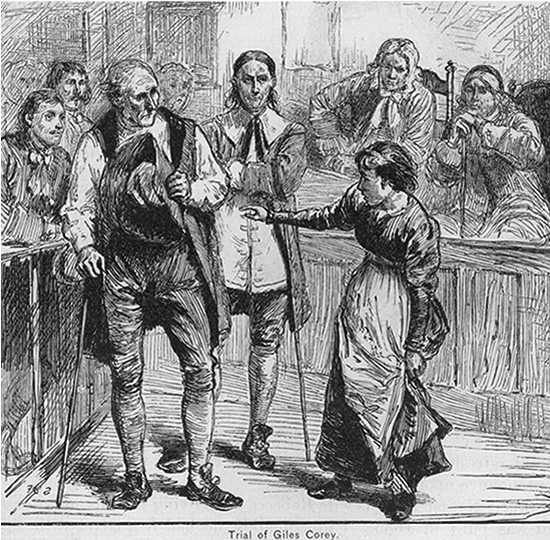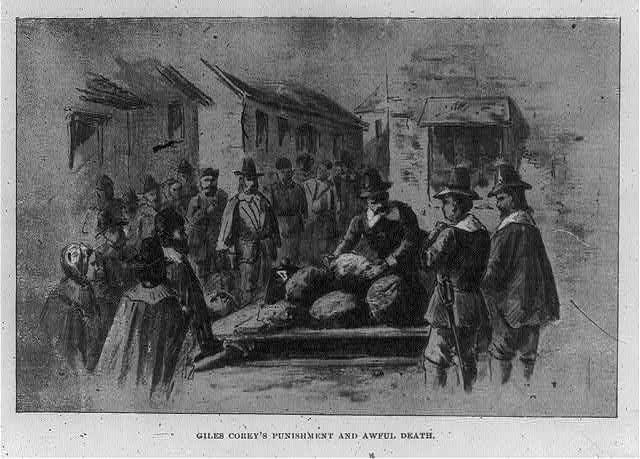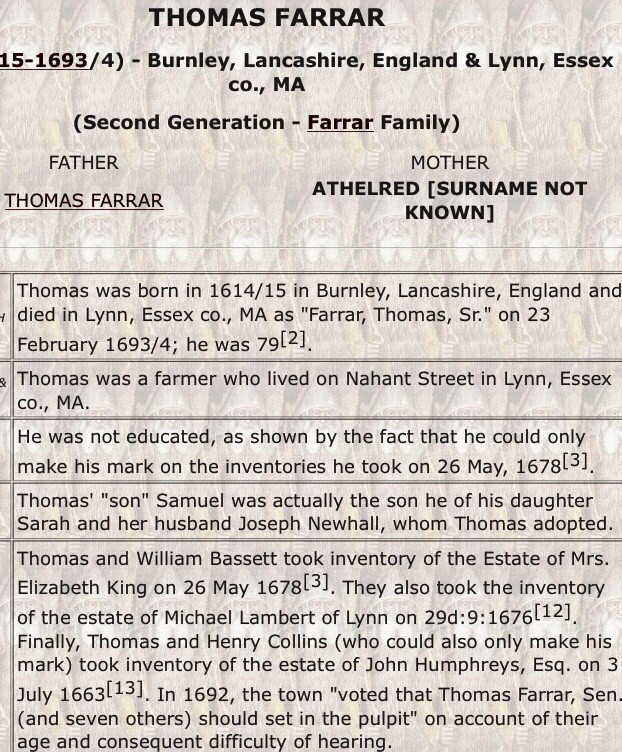|
Thomas “Old Pharoah” Farrar Sr., was a man born in Burnley, Lancashire, England on January 29, 1614, who later emigrated to Massachusetts while it was still a colony. Little did he know that at the age of 78 he would be accused of witchcraft at the Salem Witch Trials in Salem, Massachusetts on May 8, 1692. Thomas Farrar is my 10th great-grandfather (great-great-great-great-great-great-great-great-great-great grandpa!) on my mother’s side. Believe it or not, no one knew about this story at all. I certainly hadn’t heard about it because I can tell you that my jaw dropped when I found him and all the records that were showing up relating to the witch trials. On the other hand, however, it may not really be too surprising if this wasn’t exactly a family story they wanted passed on to the next generations. Being accused and put on trial for witchcraft wasn’t exactly the most honorable thing to have happen to you in the late 1600s. I came across this family member while researching through records of his son, Stephen Farrar, where within the records it listed his parents as Thomas Farrar and Elizabeth (no surname). If you’re familiar with using Ancestry, you can add the record and also create new records for parents relatively at the same time, which is what I did. Within a few minutes of adding “Thomas “Old Pharoah” Farrar Sr.” to my tree, I had over a dozen “leaves” (hints) from Ancestry. At this point, my brain was getting so excited because for there to be that significant amount of hints for a person who lived over 300 years ago tells me there was a reason for such heavy documentation of his life. For good reasons or bad was something I was about to find out. In our family’s case, it wasn’t so good. Although, for me at least, I was still really excited and thought it was very interesting to discover we had family involved in a huge historical event that many people in the United States are still fascinated by today. If you aren’t entirely familiar with the Salem Witch Trials, it may be worth perusing some basic Wikipedia pages before continuing on with this story. Here are some links for those needing a refresher: Salem Witch Trials Synopsis: https://en.wikipedia.org/wiki/Salem_witch_trials#Recorded_witchcraft_executions_in_New_England Ann Putnam (Jr) - One of the many teenager accusers: https://en.wikipedia.org/wiki/Ann_Putnam My relative, Thomas, was not only involved in the Salem Witch Trials, but accused by little Mis Ann Putnam (Jr.) herself (yes, the one known as “Ruth” from “The Crucible” that we all read or watched in school). I weirdly felt honored by this, and had to keep reminding myself about the seriousness of the situation to give myself a reality check. According to official records kept from the ordeal, Thomas Farrar Sr. was accused of torturing Ann Putnam through witchcraft and trying to make her write in his book. To quote the passage from Ann Putnam’s “deposition”: “…there appeared to me the apperishion of an old gray head man, with a great nose, which tortured me, and almost choaked me, and urged me to writ in his book; and I asked him what was his name and from whence he came, for I would complain of him; and people used to call him old father pharaoh; and he said he was my grandfather, for my father used to call hi father; but I tould him I would not call him grandfather for he was a wizard and I would complain of him; and ever since he hath afflicted me by times, beating me and pinching me and almost choaking me and urging me continewally to writ in his book.” (History of Lynn, p. 295) SPOILER ALERT: She’s lyin’. And if you didn’t know that, you’ve only had over 300 years to figure it out. The outcome for those accused of witchcraft was often death in a variety of ways. Some actually died in prison. Others were hanged, while a few were tortured by means of peine forte et dure. This was a method of placing the accused beneath an increasingly heavy load of stones in an attempt to make them enter a plea; unfortunately, it killed those who refused to give in. To my surprise, Thomas Farrar wasn’t killed, but sent to prison in Boston for several months, where it is said he “narrowly escaped with his life” (p. 75) I tried understanding why he received the sentence he did: Could it have been because he was such an old man at the time? Was it because he was a man a not a woman? Unfortunately, the records I have access to don’t explain the reasoning behind the sentencing he received, but this may be a point of future research later on to help learn more about the trials themselves. Now if you’ve made it this far, I have to share my theory for why a poor, old, 78-year-old man was one of the many targets of false accusations by a bunch of teenagers that seemed to have nothing better to do with their time. This theory involves another family that had multiple people accused of witchcraft during 1692, as well. That is the family of William Bassett, a known Quaker. Quakers weren’t fully accepted by the Puritans of Massachusetts, although there was a push for tolerance. Apparently, though, a lot of those accused were found within the Quaker population. There are also theories that people had personal vendettas with people in their community and used accusations as a means to get rid of them and acquire their land and property. Thomas Farrar Sr.’s granddaughter, Rebecca Berry was married to a man named William Bassett Jr. (son of William Bassett). This connects Farrar to the William Bassett Sr. family through marriage. William Bassett Sr. had a sister, Elizabeth accused of witchcraft. Her husband then was accused of being a wizard for standing up in her defense, in which both ended up convicted, the husband ultimately hanged. William Bassett Sr.’s wife was also accused of being a witch and imprisoned, later released. In further connection to the Bassett family, there is documentation that Thomas Farrar Sr. took inventories of estates of different people in partnership with William Bassett. This told me there was some sort of relationship between the families beyond marriage relations; they seemed to have worked together in some capacity. The records note that they took inventory of “the Estate of Mrs. Elizabeth King on 26 May 1678. They also took the inventory of the estate of Michael Lambert of Lynn on 29 September, 1676. Finally, Thomas and Henry Collins took inventory of the estate of John Humphreys, Esq. on 3 July 1663.” In addition, Thomas’s wife, Elizabeth, had died in 1680, meaning at this point in time he was left to defend himself, as well. Making him even more an easy target. So, here we have two men and their family members being accused for witchcraft. With the context I have provided, it is possible that one of the family’s they conducted inventories for wasn’t happy with their work, and then throw in the Quaker religious background, and Farrar’s general isolation as an older widower, they and their families were perfect targets for these false accusations of disgruntled community members. If you're interested in learning similar stories about your own family, please comment or reach out via my contact options found on my website!
35 Comments
I will be sharing my first story soon! Thank you for your patience.
- Ashley |
AuthorThis blog is meant to introduce you all to the people I have found during my research, and to see that there is no such thing as a "boring family". Archives
January 2020
Categories |
Location |
|




 RSS Feed
RSS Feed